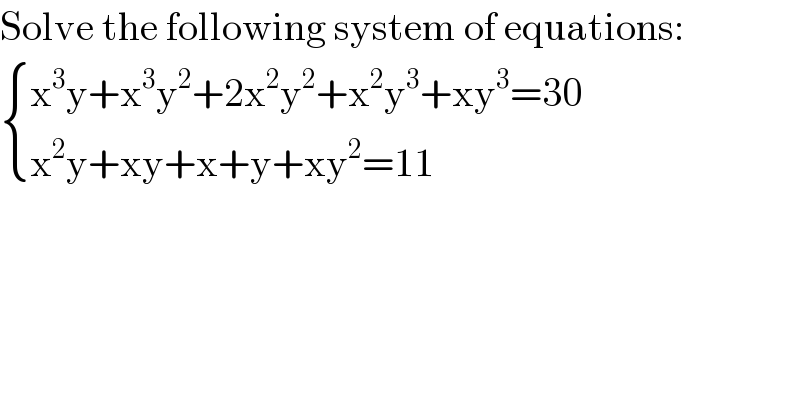
Question and Answers Forum
Question Number 105704 by 1549442205PVT last updated on 31/Jul/20

Commented by PRITHWISH SEN 2 last updated on 31/Jul/20

Commented by PRITHWISH SEN 2 last updated on 31/Jul/20

Answered by 1549442205PVT last updated on 31/Jul/20
![Set x+y=u,xy=v we have (1)⇔xy(x^2 +y^2 )+(xy)^2 (x+y)+2(xy)^2 =30 ⇔xy[(x+y)^2 −2xy]+(xy)^2 (x+y)+2(xy)^2 =30 (x+y)^2 (xy)+(xy)^2 (x+y)=30 (2)⇔xy(x+y)+xy+x+y=11. { ((u^2 v+v^2 u=30)),((uv+i+v=11)) :}⇔ { ((uv(u+v)=30)),((uv+u+v=11)) :} Set u+v=m,uv=n⇒ { ((m+n=11)),((mn=30)) :} ⇔(m,n)∈{(5,6),(6,5)} i)(m,n)=(5,6)⇔(u,v)∈{(3,2),(2,3)} +(u,v)=(3,2)⇔ { ((x+y=3)),((xy=2)) :}⇔(x,y)∈{(2,1),(1,2)} +(u,v)=(2,3)⇔ { ((x+y=2)),((xy=3)) :}⇒(x−y)^2 =(x+y)^2 −4xy=−8<0 This case has no roots ii)(m,n)=(6,5)⇔(u,v)∈{(5,1),(1,5)} +(u,v)=(5,1)⇔ { ((x+y=5)),((xy=1)) :}⇔ { ((x+y=5)),(((x−y)^2 =(x+y)^2 −4xy=21)) :} ⇔ { ((x+y=5)),((x−y=±(√(21)))) :} ⇔(x,y)∈{(((5+(√(21)))/2),((5−(√(21)))/2)),(((5−(√(21)))/2),((5+(√(21)))/2))} +(u,v)=(1,5)⇔ { ((x+y=1)),((xy=5)) :}⇒(x−y)^2 =(x+y)^2 −4xy=−19<0 so this case has no roots Thus,the given system has four roots: (x,y)∈{(1,2),(2,1),(((5+(√(21)))/2),((5−(√(21)))/2)),(((5−(√(21)))/2),((5+(√(21)))/2))](Q105737.png)
Commented by 1549442205PVT last updated on 01/Aug/20

Commented by PRITHWISH SEN 2 last updated on 31/Jul/20

